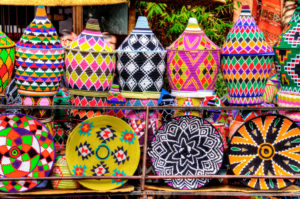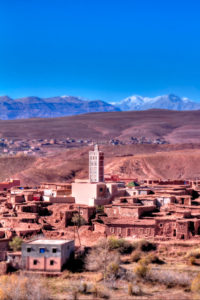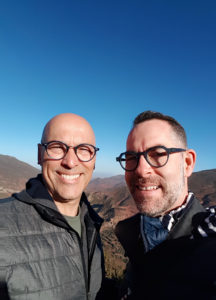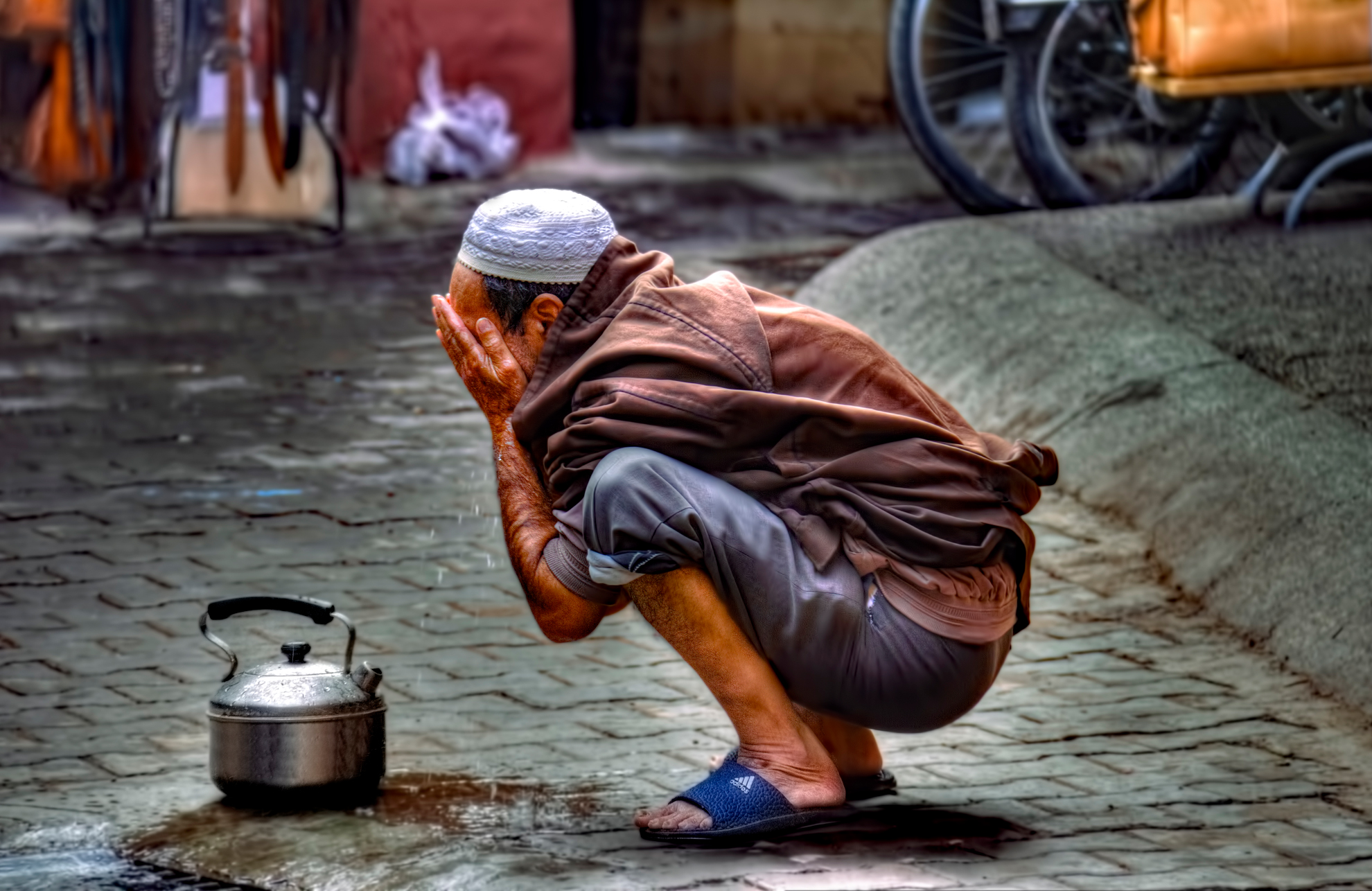After another good breakfast prepared by Hayat, we said goodbye to brother and sister, and drove away in our petit taxi to the Fez train station. Onboard the train, with snacks and Kindles in hand, we settled in for the eight hour train ride to Marrakesh. The route, although quite long, was scenic; the ride, uneventful. At the arrival station, we were greeted by our driver (included in our Airbnb stay), who chauffeured us to the entrance of the medina. Philippe, the caretaker, was waiting there to guide us to our Airbnb apartment, Dar Eden. Along the way, he pointed out the recommended juiceries, cafés and snack-bars of the medina, as well as the ones to avoid. As with Fez, the caretaker dropped in every day to check in and to coordinate any services we required. We also had a cook, Fatima, who served breakfast every day, and prepared dinners as requested. As much as we appreciated the luxury, the daily interruptions were beginning to feel a little intrusive.
 The medina in Marrakesh had a lively-to-frenetic atmosphere that contrasted with the calm-going-on-eerie vibe of Fez’s. It’s layout differed, as well: flat compared to the other’s hills and valleys; wider, vehicle-laden streets, in contrast to the pedestrian-only medina of Fez. However, like Fez, we enjoyed the aimless walks through streets and souks, trying to ignore the incessant calls to “just have a look inside”, and trying not to stare too long at the monkey handlers and the snake charmers of Jemaa el-Fna – slowing down gets you a snake around the neck, as we found out. During one of our many walks around the medina, we stopped at Salama café for its 2-for-1 happy hour. While sipping our gin & tonics, we chatted with the group of Brits beside us, deliberating on what they should do during their short stay. They were jealous of our 7-month journey; we were jealous of their access to cheap flights and destinations. Others joined us and, suddenly, there was a group of travellers having a very nice, social afternoon.
The medina in Marrakesh had a lively-to-frenetic atmosphere that contrasted with the calm-going-on-eerie vibe of Fez’s. It’s layout differed, as well: flat compared to the other’s hills and valleys; wider, vehicle-laden streets, in contrast to the pedestrian-only medina of Fez. However, like Fez, we enjoyed the aimless walks through streets and souks, trying to ignore the incessant calls to “just have a look inside”, and trying not to stare too long at the monkey handlers and the snake charmers of Jemaa el-Fna – slowing down gets you a snake around the neck, as we found out. During one of our many walks around the medina, we stopped at Salama café for its 2-for-1 happy hour. While sipping our gin & tonics, we chatted with the group of Brits beside us, deliberating on what they should do during their short stay. They were jealous of our 7-month journey; we were jealous of their access to cheap flights and destinations. Others joined us and, suddenly, there was a group of travellers having a very nice, social afternoon.
When our legs got tired from walking and our heads overstimulated by the din of the medina, we would hang out on  Dar Eden’s warm rooftop patio, a calm place to relax and take in the sunrays. For deeper relaxation, we booked time at a nearby hamman for a gommage (full body scrub) and massage. This was our first gommage experience: after stripping down and putting on a robe, we were guided to a steam room with two long cushioned benches, each barely wide enough for us to lie on. Standing in our undies, we were drenched in warm water; then, lying down, lathered with Moroccan black soap (made of black olive paste) and scrubbed hard all over with a Kessa glove – you can ask them to go softer if you’re feeling wimpy. Not us! Rinsed with more buckets (literally) of water, we were then covered with clay and left to “cure” – in hindsight, we should have brought spare underwear. More buckets of water to ensure a thorough rinse; then, moisturized in argan oil. That 45-minute treatment would have been enough to relax us; but, we were immediately ushered to our massage room. Usually, we wouldn’t need to describe a massage; but, this one, while very relaxing, had its – hmm, how shall we say – quirky moments. Occasionally, our massage therapists seemed distracted and barely applied any pressure; then, as if suddenly awaken, put herculean effort on a random spot. What really got us questioning the “school of massage” they were following was when our therapists got up onto the massage table and straddled our heads. Yes, in case you were wondering, we were fortunately facedown at the time. After ending the treatment in the resting room, with our used Kessa mitt in hand, we headed back to Dar Eden for a cozy evening in front of the fireplace, waiting for the rainstorm to arrive.
Dar Eden’s warm rooftop patio, a calm place to relax and take in the sunrays. For deeper relaxation, we booked time at a nearby hamman for a gommage (full body scrub) and massage. This was our first gommage experience: after stripping down and putting on a robe, we were guided to a steam room with two long cushioned benches, each barely wide enough for us to lie on. Standing in our undies, we were drenched in warm water; then, lying down, lathered with Moroccan black soap (made of black olive paste) and scrubbed hard all over with a Kessa glove – you can ask them to go softer if you’re feeling wimpy. Not us! Rinsed with more buckets (literally) of water, we were then covered with clay and left to “cure” – in hindsight, we should have brought spare underwear. More buckets of water to ensure a thorough rinse; then, moisturized in argan oil. That 45-minute treatment would have been enough to relax us; but, we were immediately ushered to our massage room. Usually, we wouldn’t need to describe a massage; but, this one, while very relaxing, had its – hmm, how shall we say – quirky moments. Occasionally, our massage therapists seemed distracted and barely applied any pressure; then, as if suddenly awaken, put herculean effort on a random spot. What really got us questioning the “school of massage” they were following was when our therapists got up onto the massage table and straddled our heads. Yes, in case you were wondering, we were fortunately facedown at the time. After ending the treatment in the resting room, with our used Kessa mitt in hand, we headed back to Dar Eden for a cozy evening in front of the fireplace, waiting for the rainstorm to arrive.
 A well-timed cooking class turned our first and only rainy day in Morocco into a fun-filled day. Faim d’Épices cooking school leads daily small group classes on their farm, a 20-minute drive outside of Marrakesh. The van picked up all eight participants – couples from Romania, United States, Britain, and Canada (us). The menu for that day was a beef, pear and candied orange peel tajine, salads and breads. While we waited for the class to begin, we were greeted by a few friendly, and one less friendly, cats. Later on, the room would include more cats, a dog and a couple of chickens – how they all cohabitated in this space made it feel almost normal. Almost! Part of the four hour class included a Moroccan spice workshop. Michel, one of the owners, guided us in the identification of herbs and spices through a blindfolded, guess-that-spice smelling game. After many incorrect attempts, he would divulge the answer and then explain how the spice is used in Moroccan cuisine. It was learning with fun! The cooking part was also well designed, with a balance of demonstration and hands-on practice. We even made our own bread and msemen – a buttery Moroccan pancake – with varying degrees of success. In late afternoon, we said goodbye to our cooking mates and the Faim d’Épices team, just as the sky was clearing.
A well-timed cooking class turned our first and only rainy day in Morocco into a fun-filled day. Faim d’Épices cooking school leads daily small group classes on their farm, a 20-minute drive outside of Marrakesh. The van picked up all eight participants – couples from Romania, United States, Britain, and Canada (us). The menu for that day was a beef, pear and candied orange peel tajine, salads and breads. While we waited for the class to begin, we were greeted by a few friendly, and one less friendly, cats. Later on, the room would include more cats, a dog and a couple of chickens – how they all cohabitated in this space made it feel almost normal. Almost! Part of the four hour class included a Moroccan spice workshop. Michel, one of the owners, guided us in the identification of herbs and spices through a blindfolded, guess-that-spice smelling game. After many incorrect attempts, he would divulge the answer and then explain how the spice is used in Moroccan cuisine. It was learning with fun! The cooking part was also well designed, with a balance of demonstration and hands-on practice. We even made our own bread and msemen – a buttery Moroccan pancake – with varying degrees of success. In late afternoon, we said goodbye to our cooking mates and the Faim d’Épices team, just as the sky was clearing.
Télouet and Aït Benhaddou
 On a much sunnier morning, we headed out with our driver and guide, Saïd, toward the High Atlas mountains. During the three hour drive, we left the flat plains of Marrakesh and climbed the winding Tizi n’Tichka pass, looking up onto snow capped peaks. The views were both dizzying and breathtaking! At 2,260 metres – as indicated by a road sign – we reached the top of the pass and began our descent to Télouet, a small Berber village that served as a stop to passing merchant caravans. Today, Télouet is an off-the-beaten-track tourist stop – I suspect because of the rough and narrow road leading to it – for those who wish to visit its crumbling, 19th century Kasbah. Saïd guided us through the fortress-like structure and into the opulent palace – added in the early 20th century – giving us the history of the pasha and his family who lived within. As the only visitors onsite, we were able to take our time exploring every room, door and tile. After a thorough visit in Télouet, we drove down to the very popular village of Aït Benhaddou to see its most famous Ksar. The Ksar Aït Benhaddou, another UNESCO World Heritage Site – we’ve now lost count – is the site of numerous Hollywood films, but the locals still point out where different scenes of Gladiator were shot, even over 17 years later. As we wandered through its streets, up to the hilltop fortified granary, we took in the views of the plains and Atlas mountains beyond. This scenery, like others in and around Marrakesh, is best appreciated in the photo gallery.
On a much sunnier morning, we headed out with our driver and guide, Saïd, toward the High Atlas mountains. During the three hour drive, we left the flat plains of Marrakesh and climbed the winding Tizi n’Tichka pass, looking up onto snow capped peaks. The views were both dizzying and breathtaking! At 2,260 metres – as indicated by a road sign – we reached the top of the pass and began our descent to Télouet, a small Berber village that served as a stop to passing merchant caravans. Today, Télouet is an off-the-beaten-track tourist stop – I suspect because of the rough and narrow road leading to it – for those who wish to visit its crumbling, 19th century Kasbah. Saïd guided us through the fortress-like structure and into the opulent palace – added in the early 20th century – giving us the history of the pasha and his family who lived within. As the only visitors onsite, we were able to take our time exploring every room, door and tile. After a thorough visit in Télouet, we drove down to the very popular village of Aït Benhaddou to see its most famous Ksar. The Ksar Aït Benhaddou, another UNESCO World Heritage Site – we’ve now lost count – is the site of numerous Hollywood films, but the locals still point out where different scenes of Gladiator were shot, even over 17 years later. As we wandered through its streets, up to the hilltop fortified granary, we took in the views of the plains and Atlas mountains beyond. This scenery, like others in and around Marrakesh, is best appreciated in the photo gallery.
Another section of our journey completed, we said goodbye to the frenetic streets and warmth of Marrakesh and headed north.


One thought on “Marrakesh, Morocco November 28 – December 5, 2017”
Indeed a massage to remember for a very long time! Thanks for a good laugh!
Comments are closed.